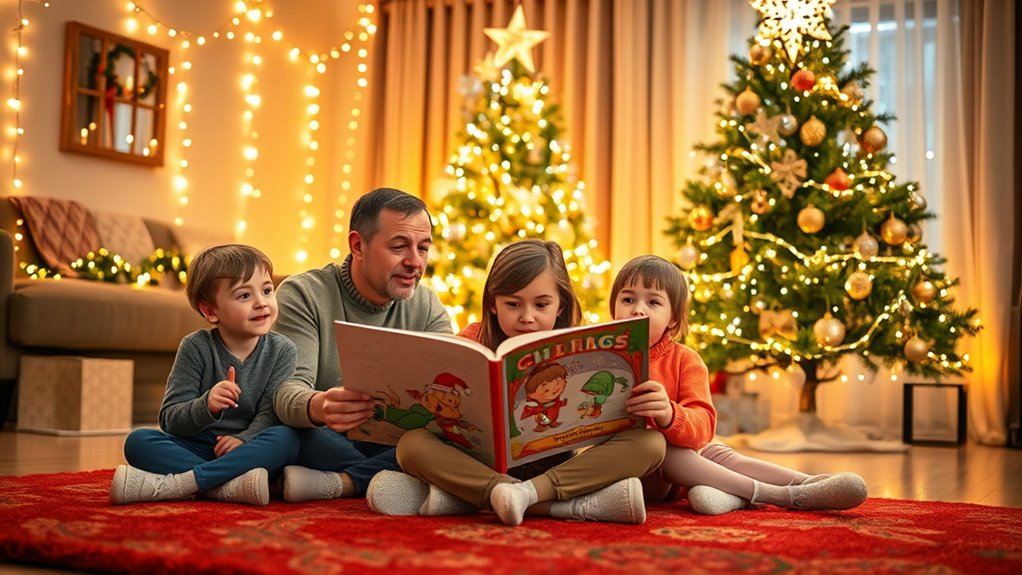Christmas is a special time rooted in kindness, love, and sharing. It celebrates the birth of Jesus and has grown through traditions like gift-giving, decorating trees, and singing carols. The holiday encourages us to be generous and caring, helping others and sharing joy with family and community. By understanding these meaningful stories and traditions, you can help your children see Christmas as more than just festivities—if you keep exploring, you’ll discover even more about its true spirit.
Key Takeaways
- Christmas celebrates the birth of Jesus, emphasizing love, kindness, and giving to others.
- Sharing, giving gifts, and helping those in need reflect the true spirit of Christmas.
- Stories of Santa and community acts teach children about compassion and generosity.
- Celebrating with family traditions and holiday activities strengthen bonds and create joyful memories.
- Leading by example and involving children in giving and caring deepen their understanding of Christmas values.
The History Behind Christmas Celebrations

Have you ever wondered how Christmas became the joyful holiday we celebrate today? The origins of Christmas trace back over 2,000 years to early Christian traditions honoring Jesus’s birth. Over time, various holiday customs blended with older pagan festivals, like Saturnalia, to create the festive atmosphere we know now. In medieval Europe, Christmas became a time for feasting, singing, and gift-giving, shaping the holiday customs we still enjoy. As centuries passed, different cultures added their unique traditions, from decorating trees to exchanging presents. Today, these historical influences combine to make Christmas a celebration of joy, family, and community. Understanding its history helps you see how centuries of customs have transformed into the cheerful holiday we cherish today. The evolution of holiday traditions reflects how cultural exchanges over time have shaped modern Christmas celebrations.
The Significance of Giving and Sharing

Giving and sharing are at the heart of Christmas because they remind you of the importance of kindness and caring for others. When you participate in charitable acts or community service, you show your loved ones that helping others is valuable. These acts teach children that sharing their time, resources, and compassion makes a difference. Whether donating toys, volunteering at a local shelter, or simply offering a helping hand, your actions create a spirit of generosity. By emphasizing the significance of giving, you help children understand that Christmas isn’t just about receiving, but also about making others feel loved and appreciated. Teaching children about empathy and compassion helps foster a lifelong habit of kindness and community-mindedness.
Stories of Compassion and Kindness

What are some stories that truly capture the spirit of Christmas kindness? You might hear about Santa’s kindness, where he brings joy to children around the world, reminding us that giving is at the heart of Christmas. Charity stories also highlight acts of compassion, like communities coming together to help those in need. For example, stories of families donating toys or volunteering show how small acts can make a big difference. These stories teach children that kindness isn’t just for Christmas day but a year-round value. When you share these stories, you help kids understand the importance of caring for others, spreading warmth and hope. Additionally, incorporating lessons about electric bikes can show how innovative transportation can contribute to a more sustainable and caring world. Celebrating Santa’s generosity and charity stories encourages children to emulate these acts of kindness in their own lives.
Celebrating With Love and Family Traditions

Stories of kindness and compassion often inspire us to share love with others, especially during Christmas. Celebrating with loved ones creates meaningful memories and strengthens bonds. You might sing Christmas carols together, filling your home with joyful melodies that remind everyone of the season’s true spirit. Decorating your space with holiday decorations adds warmth and cheer, turning your home into a festive haven. Here’s a simple way to organize your traditions:
| Family Activity | How It Celebrates Christmas | Special Moment |
|---|---|---|
| Singing carols | Spreading joy through music | Creating lasting memories |
| Decorating tree | Bringing warmth and color | Sharing smiles and laughs |
| Giving gifts | Showing love and generosity | Feeling connected and loved |
A well-lit projector screen can also enhance your holiday movie nights, making your festive viewing more immersive.
Ways to Teach Children the Spirit of Christmas

To effectively teach children the true spirit of Christmas, it’s important to lead by example and involve them in meaningful activities. Share Santa’s origins, explaining how he symbolizes generosity and kindness, rather than just gift-giving. Sing Christmas carols together, emphasizing their messages of love and hope, which reinforce the holiday’s deeper meaning. Encourage your children to participate in charitable acts, like donating toys or volunteering, to foster compassion. Use storytelling to highlight the history behind Santa and Christmas traditions, helping them understand the value of giving. Consider incorporating camping resources and guides into holiday family activities to teach cooperation and appreciation for nature. By engaging them in these activities, you help them grasp the true spirit of Christmas—one rooted in love, sharing, and community, beyond the material aspects of the holiday.
Frequently Asked Questions
How Can I Explain Santa Claus’s Role in Christmas?
You can explain Santa’s role in Christmas by telling children that Santa’s gift giving represents kindness and generosity. Emphasize that Santa’s magic helps him deliver presents all over the world in one night, inspiring wonder and joy. You might say that Santa’s magic reminds us to be good and caring, making Christmas special through the spirit of giving. This helps children understand Santa as a symbol of love and generosity during the holiday.
What Are Some Non-Religious Ways to Celebrate Christmas?
Imagine twinkling holiday lights casting a warm glow, transforming your home into a winter wonderland. You can celebrate Christmas by focusing on joyful traditions like decorating with colorful ornaments, sharing heartfelt gift-giving traditions, and enjoying festive meals with loved ones. Emphasize kindness, gratitude, and togetherness, creating meaningful memories. This approach allows you to cherish the holiday spirit beyond religious aspects, making your celebration inclusive, fun, and filled with warmth and cheer.
How Do Different Cultures Interpret the Christmas Story?
You’ll see that different cultures interpret the Christmas story through their unique cultural traditions and festive customs. In some places, you might find elaborate nativity scenes, while others celebrate with special music or communal feasts. You actively participate in these diverse customs, adapting the story’s meaning to fit local beliefs and practices. This variety enriches your understanding of Christmas, making it a globally cherished holiday rooted in shared joy and cultural expression.
What Are Simple Ways to Teach Children About Jesus’s Birth?
You can teach children about Jesus’s birth by sharing simple stories during family time, using nativity scenes to visualize the event, and emphasizing the significance behind each figure. Incorporate annual traditions like setting up a nativity scene or reading a special story on Christmas Eve. These activities create anticipation and help children understand that Christmas celebrates love, hope, and the true meaning of Jesus’s arrival in a way that feels magical and meaningful.
How Can I Address Commercialism During Christmas?
To address commercialism during Christmas, focus on meaningful holiday shopping and gift giving. You can set a budget and choose thoughtful, personalized gifts instead of material items. Emphasize spending quality time with loved ones and sharing experiences rather than buying lots of presents. Teach children that Christmas is about love and giving, not just the latest toys or gadgets, helping them appreciate the true spirit of the season.
Conclusion
As you teach children the true meaning of Christmas, remember that beneath the glitter and gifts lies a deeper message of love and compassion. While society often emphasizes material things, your guidance can reveal the beauty of kindness and shared moments. In this contrast, you help children see that the holiday’s true spirit isn’t in what they receive, but in how they give and connect — turning Christmas into a celebration of genuine warmth and generosity.









